STANLEY KUBRICK'S Full Metal Jacket
Shot-by-Shot Analysis
Part Seven

Go to TOC for this film ( (which has also a statement on purpose and manner of analysis and a disclaimer as to caveat emptor and my knowing anything authoritatively, which I do not, but I do try to not know earnestly, with some discretion, and considerable thought).
TOC and Supplemental Posts | Part 1 | Part 2 | Part 3 | Part 4 | Part 5 | Part 6 | Part 7 | Part 8 | Films Home
LINKS TO SECTIONS OF THE ANALYSIS ON THIS PAGE:
Examining the evolution of our view of the complex as we move toward the sniper
Our first view of the complex where the sniper activity will take place is from beyond Cowboy, shot 456, the interior and left of the complex obscured by a great deal of smoke.
Shot 457 follows with a more panoramic view of the complex from behind Eightball.
As Cowboy hit the end of what I will be calling the left building--for our usual view of the complex is of three buildings--the camera passes behind a column that completely blacks out the screen momentarily, then when the camera emerges on the other side Cowboy, who is not moving as swiftly as the camera, has only progressed a little, but whereas while he was looking toward the complex he is now looking at the camera.
Shot 457 following, shows Eight ball in front of the second/middle building in the distance. Because the camera is behind him, he is viewed as before the building. As the camera progresses further along, moving more swiftly than him, he too is briefly concealed by a column, only the camera is further back so the column only divides the screen rather than completely obscuring it. With the change of the camera's perspective, when it comes out on the other side of the column, Eightball's position is now instead approaching the second/middle building. It is as though he has moved back in time, but of course he has not, this is a matter of relationship perspective.
What isn't a matter of relationship perspective is that in shot 458 we see that Eightball is a number of steps ahead of Cowboy, If Eightball is, walking point, at this position, we shouldn't have seen Cowboy in that position in shot 458, he should have been further to the rear.
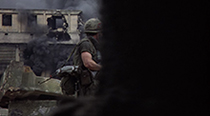
|
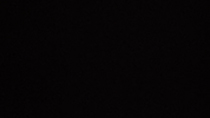
|
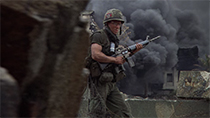
|
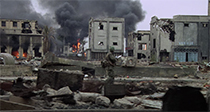
|
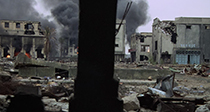
|
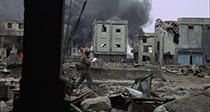
|
In fact, the moment that Kubrick ends shot 456, and moves to shot 457, Cowboy is standing at the exact place at the end of shot 456, where Eightball is standing at the beginning of shot 457. We know this by examining the concrete embankment and the placement of the concrete pylons on it.
That's planning, not happenstance, trading Cowboy out with Eightball in this manner. Later there is another interesting trade-out, which makes perfect sense, Animal Mother moving so Cowboy can step up and take a look at MY-TOAN.
It was in The Killing that Kubrick began playing with sometimes taking the camera from beyond the fourth wall (rather than just an exterior view), and dollying so that as we tracked the action the camera would pass behind a so it in some way obscured action or divided the screen. The first example of which I'm aware is our initial view of Marvin Unger's apartment, Johnny and Fay meeting at it. We are taken outside the fourth wall as Johnny pops open a beer in the kitchen, then moves out of the kitchen into a hall (no window on the opposite wall), then a center room, and finally into the front room where Fay is dressing. From beyond the fourth wall, the camera passes behind not only several walls but pieces of furniture.
Kubrick plays with this several times in Lolita. When Humbert first views Charlotte's home, she takes him up the stairs and down the landing to see his prospective room. We briefly go beyond that fourth wall as we enter his room, passing beyond a wall rather than through the door. Then we have the same effect when they exit the room, the camera passing behind the wall, they are followed down the landing, then as they enter Charlotte's room the camera passes behind that fourth wall into her room permitting us an interior view of a closet. Later in Lolita, Kubrick plays with time and space in conjunction with such a shot. Humbert is locking his diary away in his desk drawer when Charlotte enters and catches him with it. Just as when he'd first arrived, Kubrick goes back out beyond the fourth wall as Humbert gently but firmly pressures Charlotte out of what was his room but is now his study, he following her, we have a full screen black-out from the supposed wall, the briefest glimpse of light, back into full black, then they are entering Charlotte's room. We have entirely skipped the hall this time around. We have a third such shot when Humbert enters his room to find Charlotte reading his diary. Fleeing back to her room, she crumples on the floor with her first husband's urn, and the camera follows her down to the floor, and by way of going beyond the fourth wall the camera passes through the floor and into the kitchen below where Humbert has run in order to make her a drink, he yelling up at her that what she's read were just fragments of a novel. In the following shot we stay with him as he yells up at her, continuing his preparation of the drink, then the phone rings, interrupting his explanation, he rushes to answer it and learns that Charlotte has been hit and killed by a car. Kubrick has radically compressed time. Charlotte had one minute in which to put on her coat and run out in the rain to the next street where she has been struck. In a minute, she couldn't have done this and the police have already arrived, an identification made of Charlotte and a phone call made to Humbert to alert him to the accident. It makes for great black comedy but it's also Kubrick playing with time in such a way that the audience isn't going to notice how the impossible has taken place and they've accepted it as a matter of course--partly by way of the magic of film's natural elastic effect on space and time, expanding and contracting it.
Another example is had with The Shining in shots 110 and 111. Stuart showing Jack and Wendy outside the hotel on the day it closed down, as they move from the maze toward the hotel, in shot 110, Wendy asks when the Overlook was built. Stuart begins to tell her in shot 110 that it was built in 1907 to 1909 and finishes telling her this in shot 111. Between shots 110 and 111, however, the group has advanced a number of yards, so part of the actual physical portion of their journey from the maze to the garage is omitted, but with no signal of this in the conversation, which continues unbroken over the shots and connecting them.
There is a lot of Alice in Wonderland expansion and contraction of space in this section of Full Metal Jacket.
Returning to Full Metal Jacket the building on the left has looked like it would be somewhat on the same horizontal plane as the middle building, when instead we will find it is on the same plane as the TAM-PHUANG building with the balcony beiside which Cowboy will be shot.
Shot 459, below, may let one know that the building to the left is not on the same plane as the center building, but not to what degree. We are given the impression of a partial wall of RR boxes on the left.
Eightball having said that he thinks they took a wrong turn, he is sent to check out the complex where it seems they should be. In shot 466, as Eightball runs across the open area to the complex, part of the building on the left is cut off, but we are shown now more clearly the space between the left and center buildings, and a building beyond, followed by a closer view in shot 468.
Kubrick skips giving us Eightball's perspective of the interior square. Shot 469 instead gives us the sniper's perspective, their view of the square. Eightball is not the focal point of the shot, the sniper's view is. The camera rises up with them passing an L-shape formed of part of the wall having been broken out below horizontal slashes that compose the windows. We don't see Eightball entering the courtyard. The camera continues up and he is just suddenly, unexpectedly already there, in the square, standing so still that he almost seems like a still photograph, but then he will move to wave to the squad to move in, at which point he will be shot.
I pay attention to that L-shape as Kubrick emphasizes, in Lolita, how special the chess piece of the knight is with its ability to leap over other pieces and move around corners and take things--Humbert's next grabbing Charlotte's queen. The corner is also a blind spot in Kubrick's films, equated with the vanishing point, where parallel lines impossibly meet in the distance.
I'm borrowing from skiffleboom.files.wordpress.com the two images below of the set of Full Metal Jacket as displayed at the Kubrick exhibit.
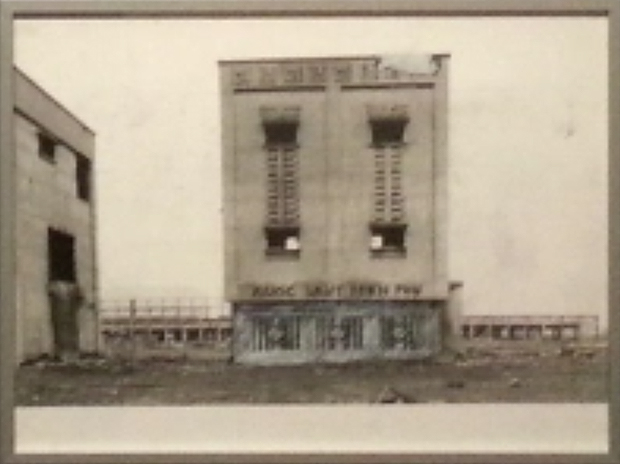
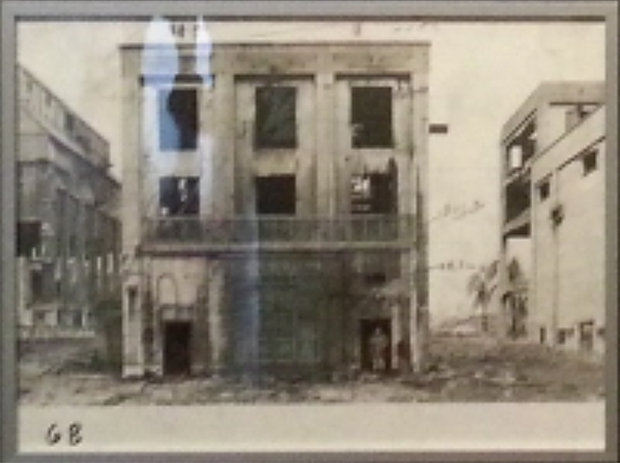
From skiffleboom.files.wordpress
The top image is of the previously mentioned middle building, but viewed from the interior of the square, so we see in the distance the structure before which the Marines are positioned. Note how the lower part appears to be colored blue. Instead, it's the far right building (viewed from the exterior of the square) that will have the doors that are colored blue.
The bottom of the two above skiffleboom images is of the TAM-PHUANG building. The structure on the left of it is not on the same horizontal plane but set further back and we don't view it in the film.
John Gulliver at Flickr provides another view of the middle building from the interior of the square.
We can compare this view of John Guilliver's with another from the Kubrick exhibit, this image robslondon.com.
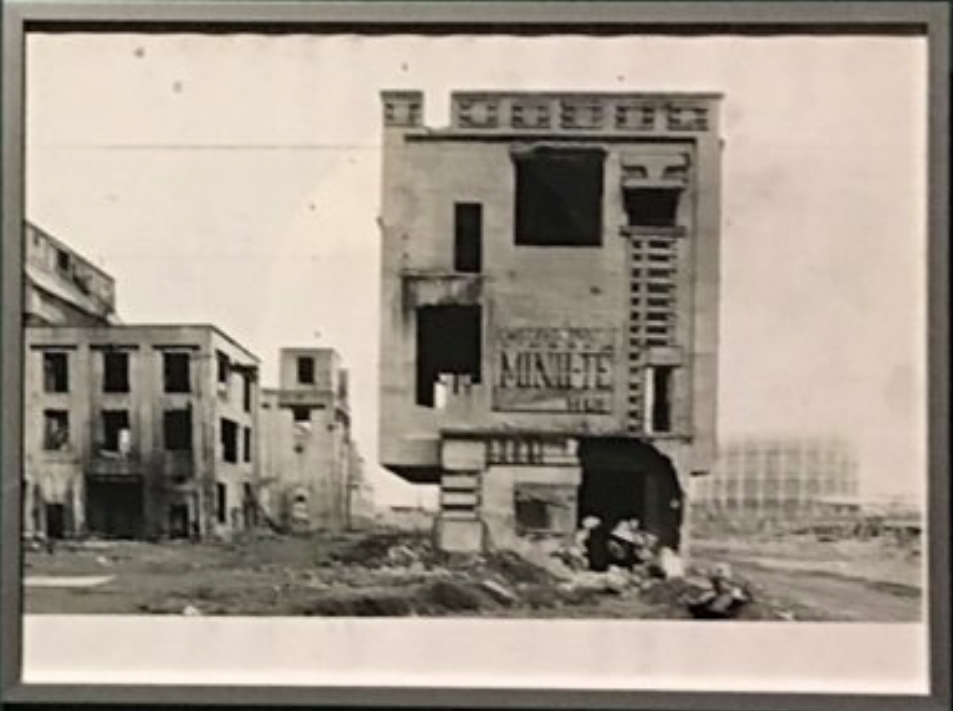
Above, on the left, we can see again what will become the TAM-PHUANG building.
They appear to have played with putting MINH-TE on the side of this center building. I don't know if the name can be translated the same but Trinh Minh The was the name of a Vietnamese nationalist and leader of the Cao Dai militia, a religious movement established in 1926, and of which the full name was "The Great Faith (for the) Third Universal Redemption", a period of time in which God and humanity would be somehow united. An objective was universal peace through uniting all religions under Cao Dai's monotheism. A symbol of theirs was Cao Dai's left eye.
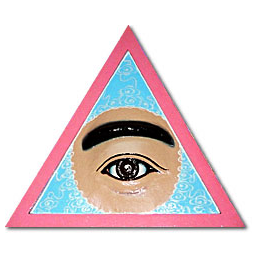
Cao Dai was critical of communism and was suppressed after the fall of South Vietnam. During the 1950s, Minh The's troops had been absorbed into the the ARVN, but it was possibly feared he might eventually oppose the government. He was assassinated by sniper fire in 1955, the incident never solved. It seems rather appropriate that we might have Minh The associated with the square over which the sniper looks, but Minh The appears to have been replaced by some other sort of banner but we can't tell what it is. Likely another ad.
In response to Eightball having been shot, in shot 470, we are now shown, from the square, where the sniper is, in that large dark-gray building surmounted by the letters MY-TOAN. We know this by the distinctive shape of the windows composed of horizontal slashes. The problem with pinpointing the location of the sniper is understanding the relationship of this building to the square, though it seems obvious.
In shot 471, rather than viewing the center and right buildings dead-on from the Marines' position across the open area from the complex, we view the buildings from more to the left. We also are now availed a view of a building further down to the right but it doesn't play much into the discussion, I want to concentrate on what is normally the "right" building, the one with the blue doors. Note that an illusion breaks the building into two by way of the top line of the building having been disrupted by shelling, and a portion of concrete dropped down so that at the left-end of the blue doors the top of the building gives the impression of being the corner of a building. The illusion is enhanced by our being unable at this point to see the facade of the building with the balcony, it now hidden from view. It's almost as if the front right building has been broken so that it appears another building has been added between the building with the blue doors and the building with the balcony. The building is further broken by how the area with the blue doors is vertically divided from the rest of the building, and and how we are unable to readily tell where the left corner of the building should be. We may indeed view a whole, intact building, but how it is broken does impact our perception of the total scene.
In shot 474 we are shown Eightball has fallen across from the building with the balcony.
But we have been given reason to expect to see a slender, tall structure on fire in the background, by way of shots 466 and 468, which should be beyond Eightball, in the area of the one story building beside the tank. Where is it? It is there, more distant than what we initially believed it might be, but from this perspective we can only see the upper portion which is hidden by smoke and has no windows, it effectively disappears.
Poot Doc Jay, against Cowboy's orders he runs in and attempts to drag Eightball to nowhere, because there is no opportunity for him to get him to a safe place.
When Animal Mother runs into the complex, in shot 509, the area is obscured by smoke, which will disorient as to his location.
What is he shooting at? The way that he runs in, obscured by smoke, when we see him in shot 510 we might even become turned around and believe he's shooting in the direction of the gray building that holds the sniper.
Instead, Animal Mother is shooting up at these buildings to the left. This is a new view, looking between the front right building and the TAM-PHUONG building. We are at shot 511 and we've yet to be given a Marines' view of the square and the MY-TOAN building. Instead, we are disoriented by this completely new set of buildings to the left. We are shown Doc Jay and Eightball three times, in shots 511, 513, and 515, from approximately Animal Mother's area, and how we view them in each shot is different, so that is also disorienting. Each view of them is actually very different in feel and how we perceive their relationship to the buildings beyond.
Doc Jay having pointed to screen left, directing Animal Mother to the sniper, then obliterated, in shot 518 Animal Mother comes around the corner of the middle building and sees this view of the MY-TOAN building.
Below is a Matthew Modine Nov 1985 shot of Animal Mother at the building's corner. We see what we would expect to see but do not in Kubrick's choice of perspective above. When we try to really orient ourselves, we know that another building should be there on the same horizontal plane as the TAM-PHUANG building, to the left of this middle building, and we know it is a huge building, but we don't see it from this view. We do later but not now. This is extremely disorienting. That black MY-TOAN building almost becomes a phantom presence, the way it keeps slipping in and out of existence.
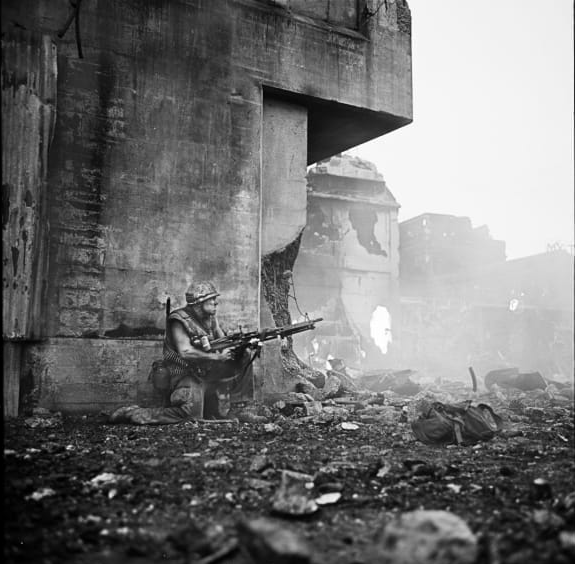
The squad, informed by Animal Mother there is one sniper, in shot 524 they cross the plane to the complex. We are given a view that makes the complex feel very distant. That building on the left *feels* like it should be related to the black MY-TOAN building, all that smoke pouring, but it isn't. It is a separate building, and the MY-TOAN building is situated further to the left. We have yet to see it.
Do we now get a running glimpse of the side of the MY-TOAN building on the far left?
The Marines have passed to the far right of the building with the blue doors, come around it, and are now running up to a building to the rear of the TAM-PHUANG building. And, fuck it all, wait, where did this building come from? Actually, it is the same building we saw in shots 511, 513, and 515, the one behind the small box building, but it feels like a completely different entity. Even after having gone through and reasoned out the map of the square several times over, I am still sometimes disoriented by it, which astonishes me.
Kubrick compresses things so that left building that we knew was on the same plane as the TAM-PHUONG building feels very close to it now. But it also doesn't feel like that far left building we have been observing from the outside, from the concrete embankment. With its black smoky side, it keeps wanting to somehow turn into the MY-TOAN building. Also, these perspectives make one wonder how in the world Animal Mother was able to see the MY-TOAN building in shot 518 without this building being in the way, as we saw in the Matthew Modine shot. With each perspective our hold on the square is broken. It's like a constantly changing cloud--all a matter of camera and perspective and the dressing of the set.
Kubrick ensures we eventually have enough of these different perspectives to resolve the puzzle of the complex that surrounds the square, so he wants us to comprehend it. Just as in The Shining he gives us enough views to understand that nothing about the hotel makes sense, that it is impossible and is intended to be comprehended as impossible, whereas the Hue complex does ultimately fit together.
A third time, the sniper's view, zeroing in on Cowboy in shot 530. By now Doc Jay and Eightball are completely forgotten by the film. Obliterated so they are now no more than rags, we have to search to find them in this shot, but their characters have been deconstructed into trash. In shots 527 and 529 above, Eightball and Doc Jay even seem forgotten by the squad, though they are but a few yards away. There seems to be almost no recognition of them. Maybe it's a matter of survival, so the screenplay builds in avoidance. But this is also the film, as if decomposition is so quick here that Eightball and Doc Jay no longer even fill the rags that remain of their clothing.
Death doesn't stop. Cowboy, hit by the sniper, is dragged around to the rear of the TAM-PHUONG building where he dies.
It's time to take down the sniper. To get payback. Joker agrees with Animal Mother on this. The squad runs up the far left side of the TAM-PHUONG building toward the MY-TOAN building, passing by the one story structure we have most clearly seen from the sniper's perspective, but it was also observed from the ground. A last glimpse of it was seen when Cowboy was looking up at the MY-TOAN building, and an edge of the tank might even be viewed in shot 532 through the hole, when he is shot. If you are feeling rather disoriented right now, you should be, because the tank, which featured so prominently, and was a rather large prop, is gone. DID YOU HEAR ME? THE TANK IS GONE! YES, I'M YELLING! I'M GOING TO YELL ABOUT A BIG TANK DISAPPEARING! The feeling is rather like when you've parked your car and when you return it's gone. You almost feel compelled to look under the other cars to see if it's there, though you know damn well it's gone. I want to look under the trash lying around the square for that missing tank. But, people, it is so gone it is like it was never there, but preceding shots attest otherwise.
The squad enters the MY-TOAN area shrouded by smoke, and will soon be in Pinewood Studios. And, yes, though Animal Mother had gunned down most of these letters, they are now back up.
From John Gulliver, on Flickr, this is MY-TOAN, or what was left of it. But the main portion is there. And it looks nothing like in the movie. No power. No mystery.
Barbarella Buchner's Flickr shot of what was left of MY-TOAN, from the side.
Again, from John Gulliver at Flickr, a view of the interior of MY-TOAN. The interior action took place at Pinewood, but shots were taken from here of the square.
Just preparing you for how, yes, I'm going to talk about how once we're on the inside of MY-TOAN, at Pinewood Studios, Kubrick chucks out the window any idea of trying to make it possibly conform with the exterior of the building.
"But it doesn't matter! It's a movie!"
I know. I know. Still, I persist in making it matter where it does matter. Such as with the removal of a fuel tank that has been a prominent feature in the square, because it plays with our "feeling" perception of the complex. It is fluid after all. Unsound. It fucks with our heads.
Cowboy radioed Murphy after Eightball was shot and had asked for tank support.
COWBOY: Murph, we're receiving enemy sniper fire. Eightball is down. Our position is about half a klick north of Checkpoint Four. Believe possible, strong enemy forces occupying buildings in front of us. Request immediate tank support. Over.
MURPHY (off screen): Roger. Understand. I'll see what I can do. Over.
COWBOY: Roger. Over and out. (To Donlon.) Stay close.
Cowboy had radioed again, Doc Jay down as well as Eightball.
COWBOY (to Donlon): Give me that fucking radio. Murph? This is Cowboy. Over.
MURPHY (off screen): This is Murphy. Over.
COWBOY: Murph, we're in some deep shit. I got two men down. What's the story on that fucking tank? Over.
MURPHY (off screen): Sorry, Cowboy. No luck so far with the tank. Will advise. Over.
The word "tank" derives from idea of a reservoir for a body of water, a pool, and became associated also with the idea of staunching, of holding back water. How it became a word for a military vehicle was because it was used as a code word, a way to keep the new vehicle secret. Those looking for a secret code word played with the idea of using cistern or reservoir, and then instead decided on the related , "tank", because it was monosyllabic and didn't feel clumsy. Interesting bit of info.
This isn't the first curious episode concerning tanks in the film. Recollect that when Touchdown had been killed, he was clearly behind only one visible tank. We had seen others, but there wasn't another tank alongside the one behind which Touchdown was walking. Murphy had gotten on the tank's radio and called Delta Actual Six. Then cut to Crazy Earl behind the tank (so people tend to confuse Murphy with Crazy Earl in those shots) and he crosses over to a second tank just a few yards over, which hadn't previously been there, behind which the squad is gathered, to tell them they will be moving up the roads to check what's out there.
One tank becomes two. And now the tank in the courtyard disappears. "They had to make it disappear for sake of aesthetics. It's better for them to go along the building as they make their way to the MY-TOAN building rather than having to go around a tank." Well, seems like that could have been thought about earlier.
It's like Kubrick has borrowed from the origins of the military "tank" and has made it a secret code in the film. What does it mean?
Where the Marines are hunkered down--facing off with the complex, which may or may not be where they should be--is ads and thus words. Words that non-Vietnamese speakers won't know. Images convey the product advertised in only a few instances, and not really. The eagle that represents batteries doesn't communicate "battery". Hynos, the tootphaste, is no longer represented by an image, that for all intents and purposes had nothing to do with toothpaste. The most prominent ad, with the boy, is for Perlon, which was another toothpaste and we see the toothpaste tube to the side. but the boy holds something in his right hand that looks like it has nothing to do with toothpaste, and the way that both hands are held n relation to his mouth look like he should be flossing. But he is wearing a white bb? And down below him appears to be a platter of...chicken? I don't know. I haven't a clue. All I know is that it's supposed to have something to do with Perlon toothpaste, but the picture of the boy in the ad doesn't really tell us this.
I don't know Vietnamese and don't want to guess at most of the names we see, but I will approach TAM-PHUONG. From the embankment, across the great divide, we can barely see that there is a sign. Those in the TAM-PHUONG building would be unable to see their sign. They see the MY-TOAN sign opposite, just as those in the MY-TOAN building are the ones who live with the TAM-PHUONG sign broadcasting at them. Phượng Hoàng is the mythical Phoenix, and Phuong by itself is also Phoenix. It was once a yin/yang dualism composed of two birds. Hoang was the masculine aspect, phuong the feminine, and represented a perfect union. The masculine, over time, was absorbed into the feminine.
The phoenix jumped out at me because of the CIA's Phoenix Program by which some 40,000 Vietnamese were killed,
From Wikipedia: "...methods of torture that were utilized at the interrogation centers included: 'Rape, gang rape, rape using eels, snakes, or hard objects, and rape followed by murder; electrical shock (“the Bell Telephone Hour”) rendered by attaching wires to the genitals or other sensitive parts of the body, like the tongue; “the water treatment”; “the airplane,” in which a prisoner’s arms were tied behind the back and the rope looped over a hook on the ceiling, suspending the prisoner in midair, after which he or she was beaten; beatings with rubber hoses and whips; and the use of police dogs to maul prisoners.''
Military intelligence officer K. Barton Osborne reports that he witnessed "the use of the insertion of the 6-inch dowel into the canal of one of my detainee's ears, and the tapping through the brain until dead. The starvation to death (in a cage), of a Vietnamese woman who was suspected of being part of the local political education cadre in one of the local villages ... The use of electronic gear such as sealed telephones attached to ... both the women's vaginas and men's testicles [to] shock them into submission."
Thus the retribution torture episode in The Phantom Blooper, the torture performed by Phuong twins. The Joker, as The Phantom Blooper, the westerner who has crossed to the other side, bears witness but is unmoved. The eyes of the tortured person beg him to put him out of his misery, to shoot him, but Joker doesn't. The person who mercy-killed Cowboy says he has no mercy. The person who mercy-killed the female sniper says he has no mercy. Which is why I think we do have a phoenix facing opposite the building where Joker will, the sniper entreating him to shoot, do so rather than leave her for the rats. Will do so to end her suffering.
Tâm can mean "heart" or "center".
Considering the cultural significance of the phoenix to the Vietnamese as a mythological bird signifying harmony, it's truly culturally demented how the CIA took the phoenix and attached it to a program that tortured and killed thousands. Some say this is what ruined the military in Vietnam.
The saga of the blue doors from the point of view of the embankment across the barren expanse. What we need to consider is that the doors are formed of 8 columns, 4 panels in each column. That's 32 square panels, and I wouldn't be surprised if it has to do with chess as that's half a chess board. At the top are decorate panels it seems. Above that is the lettering VAN-HUE. I tend to view this open door as an echo of the column that is used to bisect the scene in the foreground.
We first view the panels in shot 457. They are then obscured from view for a while. When we see them again in shot 471, the Marines firing away in response to Eightball having been hit by a snipper, the panels have changed. One of the doors had been partly opened. It is now closed.
In shot 477, Animal Mother blasts away at the doors, and we can see that two of them are open.
In shot 479, the doors appear to be closed again.
In shot 491, as Doc Jay runs toward the complex, we see the doors have taken quite a pummeling but are still holding up.
They're still intact in shot 493.
When Animal Mother runs to the complex, in shot 509, a couple of the doors are open again and a panel has been knocked out.
Animal Mother having observed where the sniper is, he crosses over and checks out the interior of the right building, looking into the blue doors. We see two of them have been blasted off.
In shot 520, Animal Mother stands before the doors, calling to Cowboy that Doc Jay and Eightball are wasted and that there's only one sniper.
The squad consequently crosses over to the complex.
If this does have anything to do with chess, which is a war game, the entire e and f columns are void, and the d3 position.
There was a lot of firing on these buildings over a length of time, and I wouldn't expect continuity to keep up with it all and be exact. So, what I am curious about is how the doors do have 32 squares. And I'm curious that one panel is open at the beginning of the scene--obviously open--and then is closed. This reminds of The Shining in which Danny has been warned to not go in Room 237, how we observe him pass by Room 237 on his his trike, return to it, stop before it, go to the doors, touch a handle, but then he thinks again when he has a vision of the two girls, withdraws his hand, gets on his Big Wheel, and rides off. What he doesn't seem to notice, what most don't notice, is in the meanwhile a door has opened across the hall and remains open throughout the remainder of the scene.
I can say this. These doors attract attention. They are different. They stand out. In a sea of beige, they are blue. If Kubrick didn't want us to notice dramatic inconsistencies in the doors, he ought not to have made them a visual draw. That's reason enough to wonder about their treatment.
The doors figure plot-wise, not just as set decoration, as it is when Animal Mother checks them out that he turns and calls out to Cowboy the situation over in the complex, and the decision is made to move over to it.
Approx 5200 words or 10 single-spaced pages.
Next: Full Metal Jacket Analysis - Part 8
Go to Table of Contents for Analysis of "Full Metal Jacket"
Link to the main TOC page for all the analyses